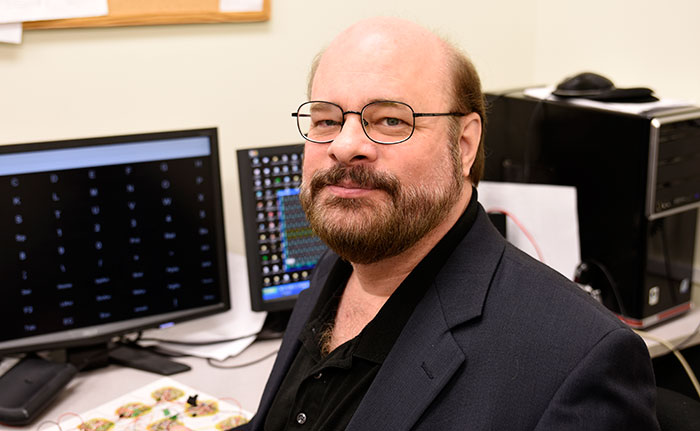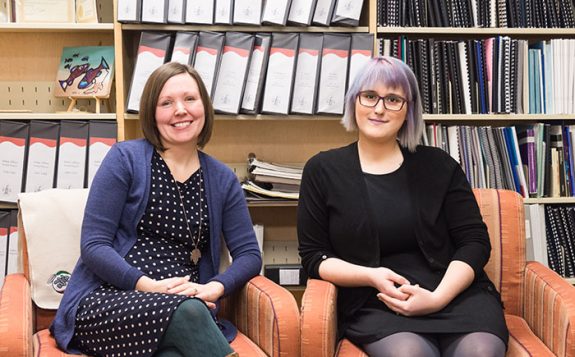Nestled in the bottom floor of the West Wing lies one of the many hidden gems of Algoma University. Tucked away in the back corner, in the former art studio spaces, are the computer science faculty offices along with the Brain Computer-Interface Lab, home of Dr. George Townsend’s remarkable, cutting-edge research. Since 2007, Townsend has devoted his academic career to helping people diagnosed with Lou Gehrig’s disease, more commonly known as ALS (Amyotrophic lateral sclerosis), convey their thoughts through sophisticated computer software and hardware. Today, he is one of the world’s leading researchers and is hoping to land himself in the Guinness World Records for his latest breakthrough.
Originally a student of Algoma University, after his first year, Townsend went on to begin studying nuclear physics. However he later switched to computer science and graduated from Lake Superior State University with a Bachelor of Science in that field. He later earned his Master of Science from the University of Waterloo and his doctorate in neuroscience from Technische Universitat Graz in Austria. Upon earning these accolades, he became a visiting scholar at the Wadsworth Center affiliated with the New York State of Health. Here, he was exposed to a computer-based interface that allowed completely paralyzed people to communicate their thoughts with the outside world. Today, this piece of technology, and numerous variations of the model, are housed in his laboratory on campus.
Essentially, the technology includes a common computer and monitor with a special EEG (electroencephalogram) amplifier and electrode cap to implement a P300-based spelling device. A person wearing the EEG cap watches the monitor for characters consisting of letters, numbers, and function keys to flash, which eventually are used to spell out a message, sentence, or word the person desires to spell. This enables a person to communicate through only brain activity and no physical movement. “This is a very old invention,” Townsend begins, demonstrating how the interface works in his lab. “It was developed in the 1980s…it’s been employed by ALS patients – that’s the biggest group that uses it. ALS gets to the point where a subject loses all voluntary control, including the ability to breathe so they have to go on ventilators. When they get to that stage, their brain is still functioning and they’re completely cognitive and aware of their surroundings. We call it ‘Locked in Syndrome’ since they’re thinking clearly but cannot communicate what they’re thinking to the outside world. At that stage, this technology will work for them, helping them to communicate, send emails, and so on.”
Since its development in the 1980s, the technology remained relatively unchanged until 2007, when Townsend began his research position at Wadsworth Center. Upon watching a demonstration of how the device performed, Townsend noted two problems with the traditional interface. He coined the terms Adjacency Distraction Problem and the Double Flash Problem to describe the two problems that had been noted by various other researchers but had never been corrected; however, Townsend developed a hypothesis to correct both problems overnight. “So I went home that night and thought about it and came back the next morning and said I think I have a solution. And that gave rise to the Checker Board Paradigm.”
The initial technology grouped the onscreen characters in rows and columns. If a person wished to select the letter S, for example, the column containing the letter S might flash, followed by the row containing the S, creating a double flash of the same letter – a duplication – known as the Double Flash Problem. “It’s two flashes in a row and your brain can’t function that fast. So you’d miss one of them and make a mistake.” The other problem, the Adjacency Distraction Problem, occurred when a letter surrounding the S flashed, and your brain would register that as the correct letter, causing a mistake to happen.
Townsend’s solution, a checkerboard virtual matrix application, however, eliminated both problems. “We overlay the 72 character matrix with a black and red checkerboard pattern so that half the characters are on red squares and half on black. The 36 characters on red squares are randomly mapped into a six by six virtual ‘red virtual matrix’ that the subject cannot see. Similarly, those on black squares are mapped into a ‘black virtual matrix’. The characters flash in traditional row-column fashion in the invisible virtual matrices but the subject sees these characters flashing in their original locations on the visible matrix. The rows of the black matrix flash first, then those of the red matrix, followed finally by the columns of each. The break between red and black flashing ensures that there will be no double flashes and the random spatial organization ensures that minimized adjacency distraction will occur. It takes a little bit more flashing to get through the matrix because in the traditional row/column method there were nine rows and eight columns, which takes 17 flashes to get through the whole thing. Now it’s going to take 24, since each of the two matrix sizes is six by six. The penalty you pay is well worth it since the accuracy rate is significantly higher.”
Townsend published his breakthrough research in 2010.
The next step in the evolution of this already impressive technology was to remove the rows and columns all together. “We wanted to know if we could create a more abstract interface. So we threw away any hint of spatial organization in the matrix… The basic principle was to make things completely open ended and only put constraints in to make things better.” Townsend published his findings in 2012 and his paper was named a Plenary Paper for its significant contribution to the field of research.
The biggest breakthrough and advancement came in the summer of 2015, when Townsend and his student assistants at Algoma broke all records. “This was a big step in the right direction. Up to now all the research I had done and all the research being done by others had only [seen] a five per cent improvement [for the participants being tested].” In the summer months, a research group reported that they had a paradigm working at 72 bits per minute – that’s the amount of information a person can get out of the brain in a specific amount of time. Expecting to make the normative five per cent increase, Townsend hypothesized that his team of researchers could hit just below 80 bits per minute by the end of the summer. “But we managed to get a big leap of 120 bits per minute, which saw a 67 per cent increase, which was unheard of! So really, all of a sudden, the field was taken to a new level.”
In order to achieve this, Townsend and his team extended the spatial organization to time as well. “Temporally what had always happened up to last summer when we did this was that the letters, however they were organized spatially, they would be organized temporally to flash in fixed (usually 1/8 of a second) increments of time. In the field we call this period of time an epoch. So eight epochs per second… So we threw away the epoch and said letters can flash whenever they want, by themselves in a group, with another letter, whatever, whenever. Left completely unconstrained, this could lead to double flashes and other problems, so we then imposed constraints to improve the interface and were left with an interface that was faster and more effective.”
The research was published in the April 2015 issue of the peer reviewed Journal of Neural Engineering. He is currently trying to get his breakthrough of 120 bits per minute into the Guinness World Records. “I don’t know if it will become an official world record but I’m trying.”
Since last summer, Townsend has been working hard to make this computer interface more accessible. With the help of his student assistants, he has developed a model interface that costs less than $50.00 by using a newer technology called a Raspberry Pi, which is a credit card sized computer. The lab has designed an EEG amplifier that can be synchronized to the video monitor eliminating timing problems that have plagued this research field for decades. It also uses a novel, innovate, inexpensive method of EEG acquisition which has received a provisional patent. “So not only is it going to be the fastest system in the world, but it’s also going to be the cheapest, making the technology completely accessible to anybody.”
While Townsend and his team of students work hard to perfect their latest creation in the BCI Lab, one thing is for certain: together, they have made a lasting impact in the fields of computer science and medical technology, helping aid the lives of thousands of people, affected by ALS and other neurological disorders.
Share Article




